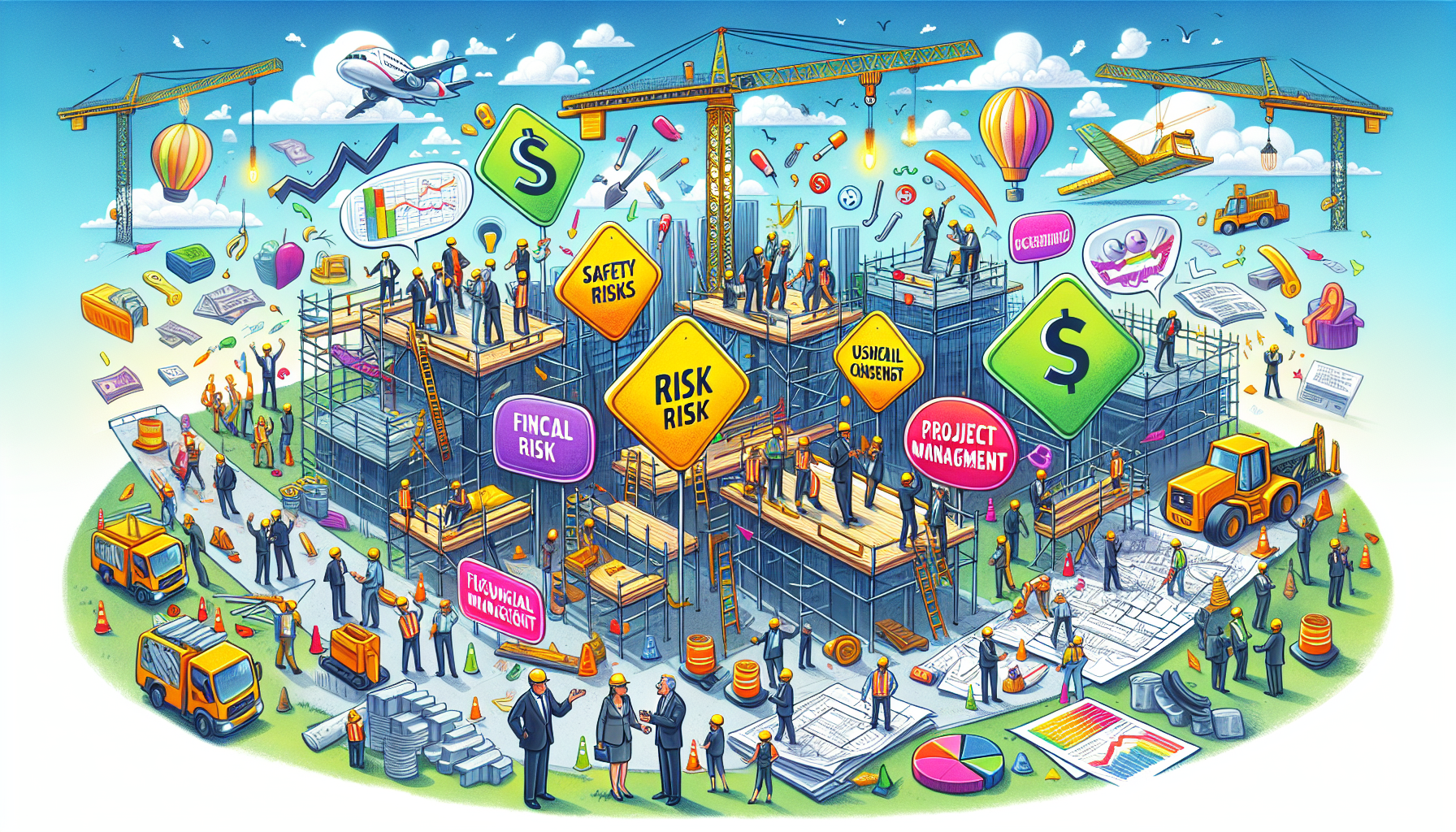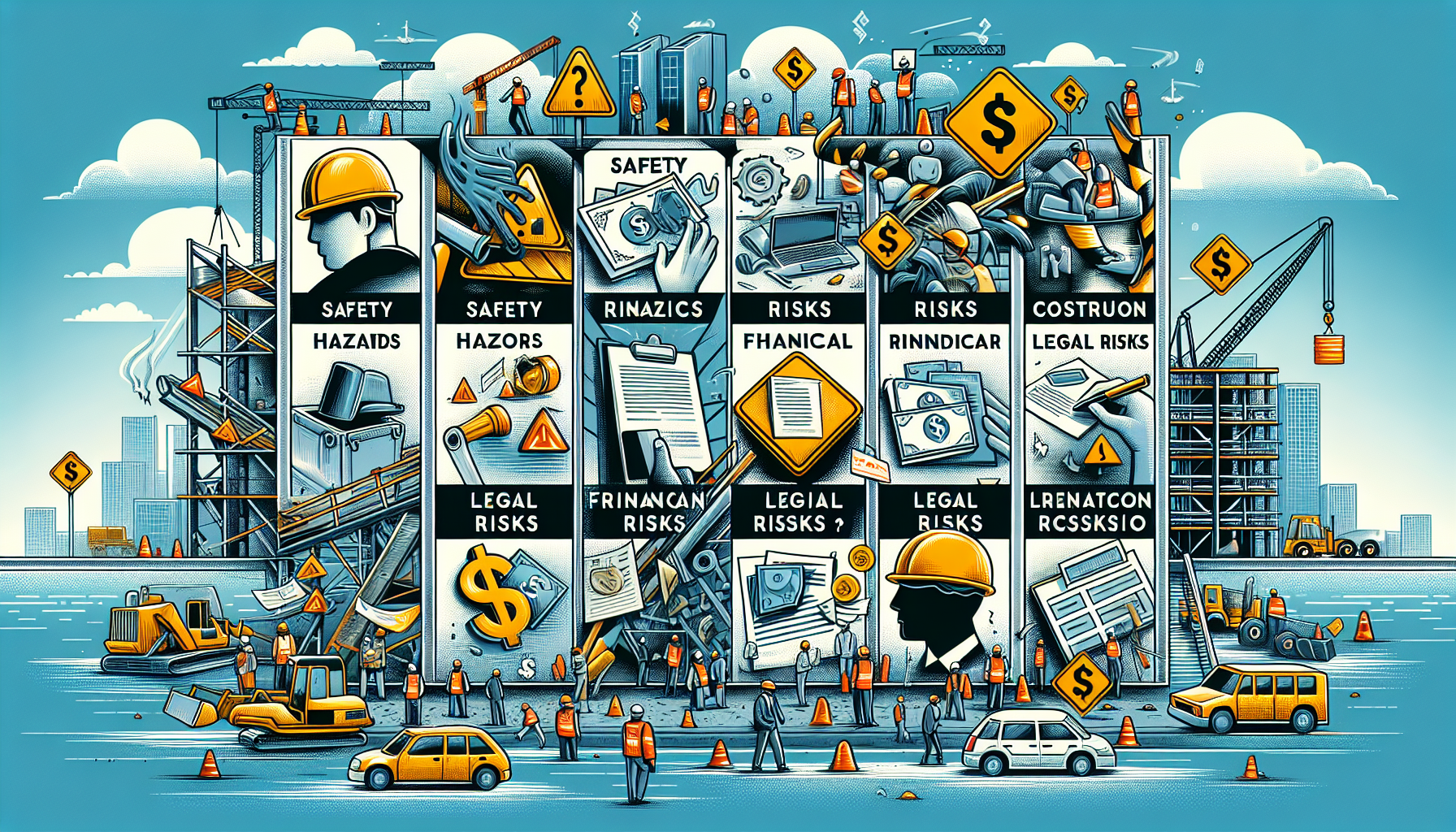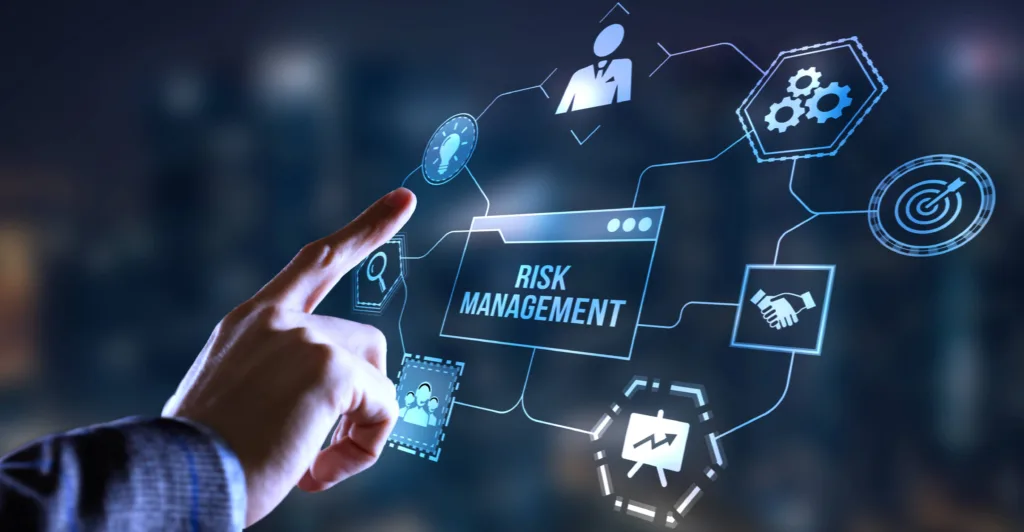Effective strategies for identifying and mitigating financial, safety, and legal risks are crucial in construction risk management to prevent project derailment. This article discusses how to manage these challenges successfully for the seamless completion of projects.
Table of Contents
Key Takeaways
Effective construction risk management is essential for identifying and mitigating various risks, including financial, safety, and legal factors, to ensure project success.
Key strategies for managing construction risks include risk acceptance, avoidance, control, and transfer, supplemented by the use of technology for data analysis and communication.
Regular reviews and updates of the risk management process are crucial for adapting to new challenges and improving safety, quality, and profitability in construction projects.
Construction Risk Management: Top Strategies for Mitigating Risk

The construction industry is fraught with risks that can disrupt even the best-laid plans. Due to the industry’s high failure rate and the complexity of projects, effective risk management is a necessity. To avoid potential project disruption, it’s crucial to identify risks, including financial, safety, legal, and operational types.
To manage construction risks effectively, responses to identified risks can include:
Acceptance
Avoidance
Control
Transfer
Such strategies help in minimizing the impact of any potential risks. Utilizing construction software further aids in managing risks by providing clear data and enhancing communication among teams.
Implementing these strategies allows construction companies to navigate project risks more effectively, ensuring smoother operations and successful outcomes.
Introduction
Risk management in construction is an essential process designed to pinpoint, evaluate, and diminish risks that may affect the execution of construction projects. The implementation of robust risk management boosts safety measures, amplifies quality standards, and elevates profit margins within these projects.
In this article, we will discuss various tactics for reducing construction risks along with the duties and accountabilities inherent in managing these risks. By its conclusion, readers should have a thorough understanding of how to navigate the complexities associated with controlling construction project risks and be prepared to apply these methods effectively in their ongoing projects.
Understanding Construction Risk Management

In the construction industry, risks come in many forms, including those that are financial, operational, safety-related, economical, legal and political. Given that this sector experiences one of the highest rates of business failures, it highlights how imperative it is for construction companies to effectively manage these project risks. Implementing successful risk management processes helps handle complex construction risks and ensures past problems do not impact future projects.
The assessment phase in managing construction risks involves evaluating both their probability and potential impact—this step is crucial for precise risk analysis. The typical responses once a risk has been recognized include acceptance of the risk as-is, avoidance through changing plans, and control by minimizing its effect. Or transferring the responsibility to another entity altogether. By continuously refining strategies with regular reviews based on new insights and previously faced hurdles in the process, improves resilience against emerging threats.
To recuperate from losses incurred due to inherent project risks may require submitting insurance claims or initiating mechanics liens alongside exploring other legal remedies available at hand. For firms operating within this domain, understanding these recovery approaches—and incorporating them when necessary—is key for mitigating an array of issues commonly encountered during construction endeavors.
Roles and Responsibilities of a Construction Risk Manager
The principal duties of a construction risk manager include:
Evaluating potential risks
Crafting strategies to address these risks
Supervising ongoing projects for any emerging issues
Enhancing the company’s operational procedures
In their role, they perform assessments on various operations and communicate findings with relevant parties. Risk managers are actively involved in visiting sites to observe existing practices and suggest areas for improvement.
Tasked with ensuring adherence to health and safety standards as well as managing insurance-related concerns, proactive engagement by risk management professionals is vital. They help avoid budgetary excesses through early detection of fiscal uncertainties within construction endeavors. Policies crafted by construction risk managers aim at both asset protection and diminishing the frequency of adverse events.
Collaboration is key. Working in conjunction with teams such as project managers and legal advisors enables them effectively reduce potential risks. These responsibilities ensure that the risk management team plays an indispensable role in advancing the triumphs and security associated with construction undertakings.
Types of Construction Risks

Construction projects are subject to a variety of construction risks such as economic, financial, legal, operational, political, and safety risk factors. Among the common risks encountered in construction are labor shortages, payment disputes, change orders project mismanagement as well as health and safety hazards.
Recognizing these different forms of construction risk is essential for implementing efficient risk management strategies within the sphere of construction.
Safety Risks
Construction is consistently ranked among the most hazardous industries due to risks like falls and electrocution. Strict safety standards should be enforced to avoid incidents and injuries on construction sites. Implementing comprehensive safety programs, including regular inspections and training, can significantly reduce workplace accidents.
Hiring experienced professionals lowers the risk of accidents in construction by ensuring a knowledgeable workforce. Daily toolbox talks and safety inspections are effective methods to address safety risks in construction projects. Wearable technology, like smart helmets, monitors vital signs and alerts team leaders to hazards, thus enhancing safety.
Continuously identifying and correcting safety risks is a key activity in promoting safety through risk management. Prequalifying subcontractors ensures that only qualified workers perform tasks on site, improving overall safety. Identifying common hazards and developing correction strategies is essential for effective safety risk management.
Financial Risks
In the construction industry, financial complications often stem from inadequate planning and coordination. When projects overshoot their financial estimates, it can result in liquidity issues for the firm involved and potentially bring project work to a standstill. Delays arising from poor scheduling can likewise lead to significant cost escalations. To sidestep funding-related delays, construction teams apply proactive strategies for managing financial risk by engaging in thorough cash flow prediction exercises.
To tackle risks associated with volatile material prices within a construction project, contractors sometimes increase their markup as a cushion against rising costs. Failing to effectively handle change orders may cause budgetary excesses and lost opportunities. The process of examining monetary risks alongside an assessment of prevailing economic conditions forms an integral component of conducting comprehensive financial risk assessments within this sector.
Legal Risks
Litigation risk in construction projects is commonly a consequence of either failing to fulfill contract terms or misinterpreting them. Construction disputes may also emerge from insufficient contract management, problems with payment, design flaws and errors, as well as substandard work quality. A single legal complication can have drastic repercussions for a business, including the potential cessation of operations.
To mitigate these risks associated with construction contracts, it’s imperative to meticulously record all aspects pertaining to the project. To sidestep conflicts over remuneration, both explicit documentation and confirmed change orders are crucial. Effective communication between clients and the construction company is paramount in reducing exposure to legal challenges. Establishing transparent client relationships is key in decreasing legal entanglements tied to construction endeavors.
The implementation of cloud-based solutions for document management enables instant access to vital documents, which aids in curtailing disagreements and possible lawsuits. The adoption of Building Information Modeling (BIM) enhances documentation processes by adding clarity that helps prevent litigation issues. Ensuring proper recording compliance with relevant regulations serves as another strategy for mitigating complications during the lifespan of construction projects.
The Construction Risk Management Process
The process of risk management in construction entails employing a structured method to manage potential risks encountered throughout the course of construction projects. Consisting of five vital stages, the construction risk management process encompasses identifying risks, evaluating their consequences, formulating response strategies, recouping losses, and analyzing outcomes. Executing each phase diligently is crucial for effectively overseeing all possible dangers and thereby bolstering the triumph of the project.
Ensuring that the risk management plan remains current through consistent revisions and updates is imperative in order to navigate emerging obstacles while maintaining ongoing safety and profitability within the project.
Identifying Risks
Identifying risks as early as the preconstruction phase allows for more effective management. Risks should be listed as soon as possible in the project timeline for early intervention. Engaging stakeholders in brainstorming sessions is a key method for identifying risks. Such sessions aim to identify numerous potential risk scenarios. These risks could adversely affect the project.
Reviewing historical production data from similar past projects can provide insights for current risks. The project team should analyze similar projects during brainstorming sessions. This includes examining their scope, location, incurred risks, and the measures taken.
The project team primarily identifies project risks while holding regular meetings to address emerging issues and potential risks. Construction risk managers review projects before bidding to determine potential profitability risks.
Assessing Risks
Risk assessment can be performed by examining the likelihood, frequency, and possible intensity of risks. It’s essential to classify these risks according to their probability of occurrence and the magnitude of their consequences. Risks that present both a high impact and a high chance should be addressed immediately as they pose notable threats. Regularly reviewing risk management strategies allows entities within the construction sector to stay attuned to industry fluctuations.
The examination of factors leading to budgetary excesses is crucial for those in construction fields in order for them to devise efficient fiscal oversight methods. Once potential risks are identified, evaluate the comprehensive risk associated with a project taking into account diverse variables.
Mitigating Risks
In the realm of construction, firms have various approaches to confront construction risks: they can accept, avoid, manage, or shift these concerns. Within the sphere of risk management for a construction project, a key tactic is to mitigate risk through careful and considered planning that aims at eliminating or reducing risks as well as judiciously accepting them when necessary. Accepting certain low probability and low impact risks may be deemed suitable. It’s critical to thoroughly evaluate their potential consequences before doing so.
Contractors are advised to develop a contingency plan specifically tailored for high priority risks which details actions that should be undertaken in response should these anticipated events materialize. Prioritizing thorough evaluation and management becomes imperative, especially with those associated with both high probability and significant repercussions upon occurrence. Managing such construction risk demands acute attention, especially when internal capabilities are already fully utilized, thus underscoring efficient allocation of available resources. In instances where eliminating said risk isn’t feasible, alternative steps must be taken including but not limited to ensuring adequate training and provision of safety gear.
To capably handle financial exposures within projects companies should engage closely with insurance entities seeking options most aptly fitting their needs toward managing monetary uncertainties effectively Contractual arrangements act pivotal roles allowing transferal mitigation between all parties entwined in project endeavors Lastly, leveraging insurance remains another strategic conduit through which such transfers might occur.
Monitoring and Reporting
Ensuring the efficacy of the risk management plan and early detection of potential issues requires a consistent cycle of monitoring. Organizing frequent meetings during the construction phase plays a pivotal role in addressing newly arising concerns efficiently. Amendments to the risk management process may be warranted given that some challenges are inevitable.
In instances where assessing the success of your risk management initiatives poses difficulties, it might be prudent to engage an external specialist with expertise in this area. Should strategies fall short, conduct thorough investigations into overlooked risks, errors in setting priorities, and lapses in communication lines. An examination of production data could indicate whether there was a decline in complications and postponements relative to past projects.
Leveraging mobile software enhances immediate field report submissions, which contribute significantly to promptness within reporting channels.
Benefits of Effective Construction Risk Management

Implementing robust risk management practices in construction is essential for achieving project predictability, controlling costs effectively, and ensuring successful outcomes. By adopting sound risk management strategies, projects are more likely to be completed on schedule and fulfill contractual commitments. Such strategies contribute to improved profitability and enhance the overall quality of project results.
By focusing on potential hazards within the construction environment, risk management fosters a safer workplace. This involves establishing comprehensive safety protocols that address these risks directly.
Enhanced Safety
Effective risk management strategies are key in minimizing the chances of workplace incidents. By implementing technology for safety oversight, one can considerably reduce accident rates at construction sites. With robust risk management and adequate safety education, numerous construction accidents can be avoided.
Educating workers on appropriate safety measures is fundamental to decreasing the potential for hazardous events. A strong commitment to proficient risk management is vital for fostering a secure work atmosphere within construction areas.
Improved Quality
Effective risk management is pivotal in attaining elevated quality levels within construction endeavors. By implementing robust risk management strategies, higher standards can be consistently maintained during the lifecycle of construction projects. Such diligent attention to managing risks contributes to strict compliance with quality benchmarks, culminating in diminished occurrences of defects and enhanced results for the project.
Placing a strong focus on ensuring quality via thorough inspections and steadfast adherence to established standards plays an instrumental role in lessening the need for rework while simultaneously achieving superior outcomes in construction initiatives.
Increased Profitability
Efficient management of risk can result in:
Enhanced stability and more accurate financial forecasts for firms within the construction sector
The preservation of a favorable cash flow, which is key to boosting profitability
A reduction in insurance expenses that has an immediate effect on the profitability of various projects
By employing strategies like securing adequate insurance coverage to transfer risk, one particular construction company realized substantial cost reductions and improved efficiency. This strategic move lessened the financial repercussions associated with unexpected events.
Utilizing Technology in Construction Risk Management
Advancements in technology have made it possible to gather and examine a large amount of data for early detection of risks. Predictive analytics uses historical data to anticipate potential risks before they occur, while sensors provide real-time monitoring that enables project managers to rapidly respond to emerging hazards.
Incorporating software tools into risk management strategies ensures the operation of construction sites both effectively and securely.
Digital Reporting and Documentation
Construction risk management is enhanced through the use of digital tools, which streamline processes and bolster both efficiency and efficacy. Software designed for managing risks aids in automating data organization and yields precise reports that improve accuracy. Digital reporting software enables the precise monitoring of risk management strategies on-site.
The potential for substantial errors due to manual input within the realm of risk management is mitigated with these digital solutions. By providing comprehensive data via digital reports, these tools refine the process of risk assessment and contribute to the creation of well-informed bids and proposals.
Safety and Quality Management Software
AI and machine learning are revolutionizing the way construction processes are carried out, resulting in a substantial decrease in risk. Autodesk Build is an instance of user-friendly BIM software that’s being implemented on construction sites. Wearable technology deployed on these sites gathers vital information from laborers, alerting team leaders promptly if there’s any deviation from the norm.
Should wearables pick up on any inconsistency, team leaders receive instant notifications to tackle the problem without delay.
Cloud-Based Platforms
Utilizing cloud-based technology facilitates the coordination of teams by allowing updates to be communicated in real time and supplying data that supports informed decision-making. This technology is crucial for granting mobile access at construction sites, which in turn ensures efficient communication. The integration of software tools within the realm of construction risk management promotes a safer and more effective jobsite environment.
Cloud storage streamlines the process of handling documents, resulting in operations that are notably more proficient. The improved version control provided by cloud storage greatly enhances document management capabilities.
Implementing Risk Management Strategies
Due to the intricate nature of construction projects and inherent risks, comprehensive planning for construction risk management is essential. A strong process in risk management allows companies specializing in construction to anticipate possible setbacks and mitigate losses, thereby enhancing profitability.
Regular enhancements and frequent evaluations of the existing risk management strategies ensure that they evolve with emerging challenges and integrate insights gained from past experiences.
Training and Education
Employees are strengthened through toolbox talks, which also maintain a focus on risks associated with the project. Software designed for risk management aids in overseeing the execution of strategies meant to manage those risks.
Collaboration and Communication
In the realm of construction risk management, teamwork plays a pivotal role in recognizing and controlling potential risks. The practice of maintaining consistent interaction and partnership within project teams is key to curtailing holdups in construction initiatives.
The utilization of collaboration instruments fosters improved discourse, mitigates workforce hazards, and heightens transparency for all involved parties — factors that are indispensable for proficient risk management. Such tools empower teams to reach more informed decisions while bolstering responsibility through the monitoring of milestones and tasks. It is imperative for risk managers to work closely with the project management team to deploy successful approaches.
Regular Reviews and Updates
Continual reassessment of risk management strategies is crucial for tackling emerging issues in construction projects. Refining these plans ensures that insights from previous endeavors and the most effective contemporary methods are integrated.
When enhancing risk management approaches, it’s important to factor in recent technological advancements as well as changes within the construction industry landscape.
Case Studies: Successful Risk Management in Construction

A prime example of efficient risk management in a construction project is seen in the healthcare facility expansion, where prioritizing safety as part of their strategies significantly lowered accident rates and allowed for earlier than planned completion of key phases. Meanwhile, an important infrastructure endeavor effectively circumvented legal issues through meticulous contract evaluations, leading to no instances of litigation throughout its development.
These case studies shed light on how pivotal customized risk management strategies are for the success of construction projects. Each instance underscores that carefully crafted approaches to managing risks are instrumental in realizing favorable results within such projects.
Summary
In conclusion, effective construction risk management is indispensable for the success and safety of construction projects. By identifying, assessing, and mitigating various risks, construction companies can enhance project predictability, control costs, and improve overall outcomes. The insights and strategies discussed in this blog post provide a comprehensive guide to navigating the complexities of construction risk management.
As you implement these practices, you will not only protect your projects from potential pitfalls, but also foster a safer, more efficient, and profitable construction environment. Embrace these strategies to ensure the sustained success of your construction endeavors.
Frequently Asked Questions
What is construction risk management?
Risk management in construction is the process of pinpointing, evaluating, and reducing risks that may jeopardize the successful fulfillment of construction projects.
Employing this forward-thinking strategy is crucial for maintaining project safety and promoting operational efficiency.
Why is risk management important in construction?
Effective risk management is essential in the construction sector. It bolsters safety measures, elevates project quality, augments profitability, and guarantees punctual completion. Appropriately overseeing risks not only safeguards a given project, but also significantly furthers the collective triumph of building enterprises.
What are the common types of construction risks?
Awareness of the various construction risks, which include financial, safety, legal, operational, economic and political influences, is essential for successful project management.
Such awareness is critical in devising effective mitigation strategies to ensure the prosperity of a project.
How can technology help in construction risk management?
Technology plays a critical role in improving construction risk management by making it easier to pinpoint potential risks, allowing for continuous monitoring in real-time, and enhancing the processes of documentation and communication.
Adopting this thorough strategy substantially reduces construction-related risks during every phase of the project’s lifecycle.
What are the benefits of effective construction risk management?
Effective construction risk management leads to enhanced safety, improved quality, increased profitability, and greater stakeholder confidence.
This strategic approach ultimately ensures a more successful project outcome.
About the Author

Taavi Kaiv
Taavi Kaiv is a construction specialist with over ten years of experience in the construction industry. Taavi is an accomplished construction project manager with many successful projects that have been completed under his guidance. Taavi holds a master’s degree in construction management from the Tallinn University of Technology. View profile






